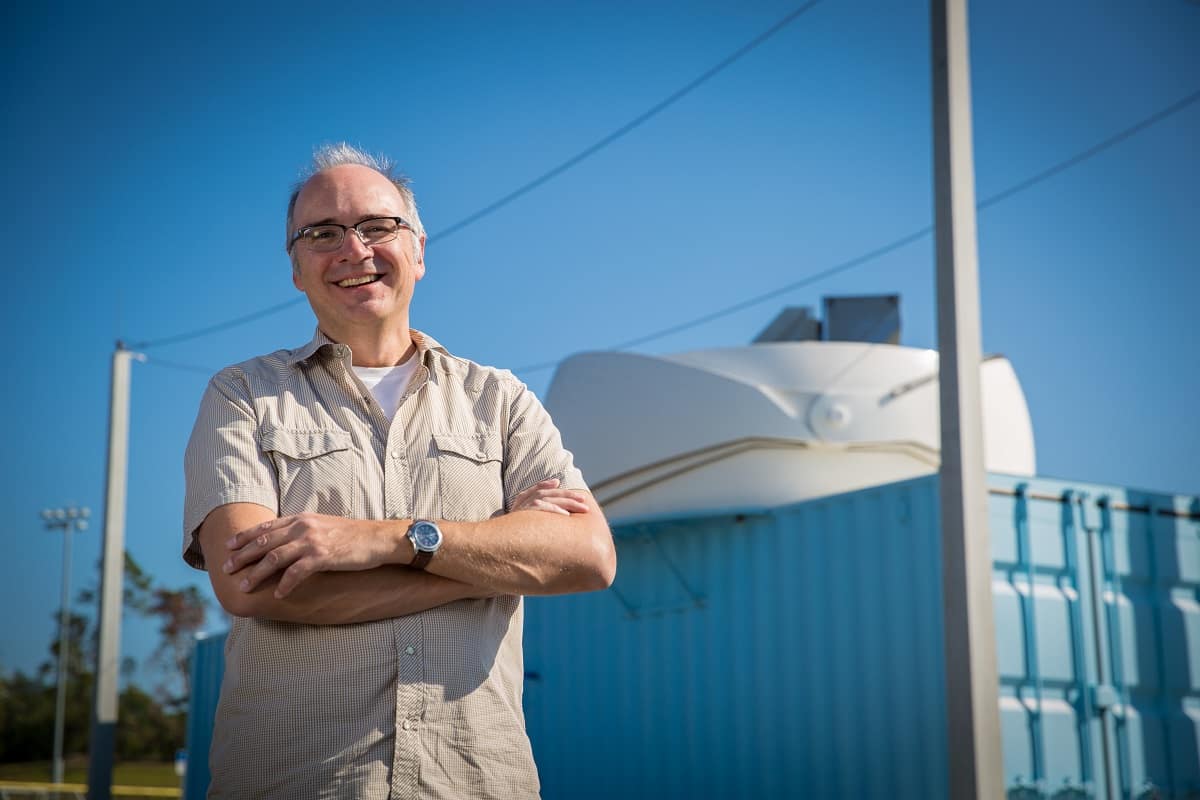Researchers Capture Light to Probe the Exosphere – the Edge of Space

Tucked behind the tennis courts on Embry-Riddle’s Daytona Beach, Fla., campus, a large blue shipping container crowned by a mysterious-looking scientific instrument is being used to capture light and better understand the very edge of space.
“You can think of the instrument as a tunable filter – a way of selecting specific wavelengths of light for study,” explained Edwin Mierkiewicz, associate professor of physics and winner of a National Science Foundation (NSF) Early Career Award.
The instrument, specifically known as a Fabry-Perot spectrometer, acts somewhat like a prism, separating light into different colors, depending on its wavelength.
Beginning at the orbit of the International Space Station and stretching nearly halfway to the Moon, the thin uppermost region of our atmosphere, called the exosphere, serves as a transition layer between the Earth and outer space. Investigations of the exosphere could ultimately provide new clues to how atmospheres change over geological time-scales on various planets – including Earth, Mierkiewicz noted.
“For example, if the Earth’s atmosphere is losing hydrogen as it escapes into space through the exosphere, we’d like to know what that rate of loss is,” Mierkiewicz said. “That information could give us insights into what happened in our atmosphere in earlier times, and what could happen in the future.”
The exosphere is chock-full of hydrogen, which is lightweight and therefore filters to the top of the atmosphere. The NSF wanted to know more about this high-flying hydrogen, including its density and distribution within the exosphere, and how it morphs in response to sunlight or other stimuli. Mierkiewicz and his colleagues have been equipping their blue shipping container with instruments to help provide answers. After the sky above campus goes dark, the researchers get busy collecting hydrogen that remains illuminated high in the exosphere.
With colleagues at the University of Wisconsin-Madison, particularly his Ph.D. student Derek Gardner, Mierkiewicz published his latest research findings in the Journal of Geophysical Research: Space Physics. That work looked in particular at light emitted by hydrogen after it was excited by sunlight in the uppermost atmosphere. Using an instrument similar to the one in his blue shipping-container laboratory, Mierkiewicz detected not only a bright type of “geocoronal hydrogen” with a red wavelength (“Balmer-α”), but also a faint blue line of hydrogen in another form (“Balmer-ß”).
The research represented a significant technical advancement. “When folks have tried this before using ground-based instruments,” he explained, “they could only see Balmer-α because it’s relatively bright, but we are using a spectrograph that allows us to capture light that’s an order of magnitude fainter, so we can pick up Balmer-ß, too.”
Supporting Student Research
Mierkiewicz said that his shipping-container laboratory, which supports a wide range of graduate-student research, is currently being equipped to function in a way similar to the University of Wisconsin-Madison’s famous “H-Alpha Mapper,” or WHAM, an observatory for studying optical emissions from the Milky Way. Once it’s fully equipped, the Embry-Riddle facility will be relocated to the American Southwest, where skies are clearer and the air is drier. It will then be remotely operated from the Daytona Beach Campus.
“The process of developing this new facility has been a great learning opportunity for students,” Mierkiewicz said.
For example, Margaret (Maggie) Gallant, who is pursuing her master’s degree in Electrical and Computer Engineering, is using the facility to model hydrogen in the exosphere. She has also played a major role in preparing the observatory.
Specifically, as a focus of her master’s thesis research, Gallant has been building a software package that will allow astronomers to remotely collect data from the facility’s instrumentation. The observatory includes an array of hardware components – from automatic focusers and calibration lamps, to the spectrometer itself – and all of them have to be independently controlled in order to accurately collect data. “My software package will need to support the remote orchestration of many different components,” she explained.
A native of Daytona Beach, Gallant said she hopes to work on instrumentation in the space industry. At Embry-Riddle, she is co-advised by Mierkiewicz and Billy Barott, professor of electrical engineering.

 Ginger Pinholster
Ginger Pinholster